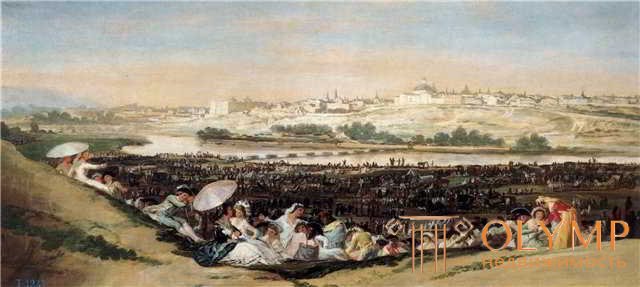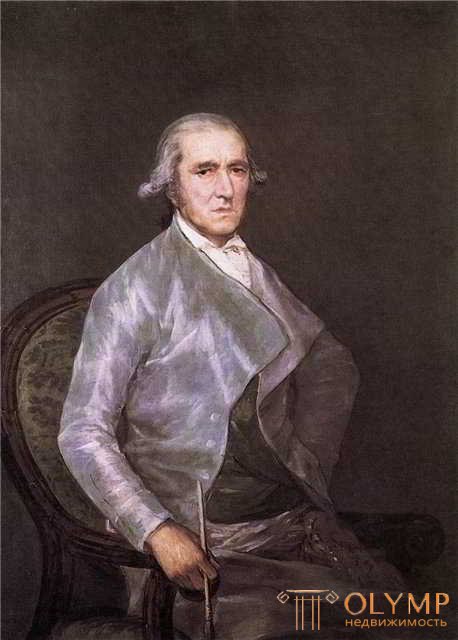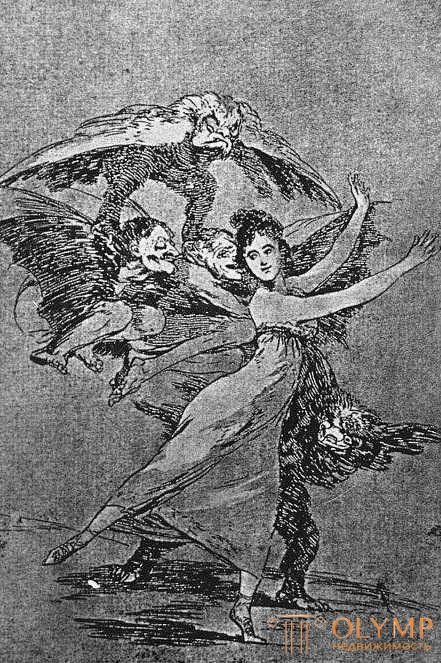
1. General overview of the development of Spanish painting
Despite strong competition with French schools, Spanish painting continues to evolve. The most influential direction remains church painting. In the second half of the century, Francisco Goya became the leading national artist.
Created in the XVII century for the whole world by Spanish painters, El Greco, Ribera, Zurbaran, Velasquez and Murillo, written in gold letters in the book of art history. But already in the last quarter of this century, the decline began, continuing through most of the XVIII century. The spirit of the time and here was stronger than the national spirit. It is remarkable that the Bourbon kings used mainly foreign artists to paint their palaces. Ferdinand VI (1746–1759), who founded the aforementioned Academy of San Fernando with the goal of making it the center of all court artistic aspirations, invited the eclecticism of Venetian Jacopo Amigoni (1675–1752) to serve in 1747, and in 1753 Corrado Jaquinto ( 1700-1765), a skillful student of Solimena and Conkb; Charles III, whose name is associated with the excavations of Herculaneum and Pompeii, appointed in 1761 his court painters to the famous Saxon Anton Rafael Mengs, whom we will talk about later, and in 1762 the purest Venetian, already familiar to us Giovanni Battista Tiepolo.
Next to them, however, were many local painters, who painted mostly churches and painted altars. The Seville school, to which Alonso Mikel Tobar (1678–1758) and Bernardo Hermann de Llorente (1685–1757) belong, fell into complete imitation of the Murillo manner. The Barcelona school gave an outstanding master in the person of Antonio Viladomatoma (1678-1755). The Madrid school, which in the first half of the century gave Pedro Rodriguez Miranda (1696–1761), a strong landscape painter, with a truly Spanish special flavor, was revived only by the foundation of the academy. Of the number of academics, the three brothers González Velázquez had an influence on modern painting, and Lüíz (1715 to 1764) painted the dome of the Madrid church of St. John with rather weak frescos. Mark, Alexandro (1719–1772) became famous as an architect and theatrical painter, and Antonio (1723–1793) performed surface dome frescoes of the Pilar del Pilar in the cathedral of the same name in Zaragoza. Even more strongly influenced was the eclectic skillful student of Mengs and one of the pillars of the academy, Francisco Bayeu y Subias (1734–1795), born in Zaragoza, and Mariano Salvador Maella from Valencia (1739–1819), a follower of Mengs and Bayeu. The most favorable impression from the works of Bayeu and Maella is made by their frescoes in the gallery of the cloister of the Toledo Cathedral.

Fig. 227. "Romeria St. Isidore." Francisco Goya's painting in Prado in Madrid
Francisco José de Goya y Lucientes (1746–1828), an inspired painter and draftsman with a strong temperament who again brought Spain to the European art movement in the eyes of posterity, left the Zaragossa school. His first teacher was one Zaragoss master, the second - his brother-in-law Francisco Bayeux. In the works glorified in our time, he searched and found completely new ways. His true teachers, he himself called nature, Velázquez - and Rembrandt. Of the works of Rembrandt, he knew, apparently, only his etchings. Goya, like Rembrandt, believed his most intimate and deep emotional experiences, mainly the etching, to which he attached the aquatint technique and, for the first time in Spain, lithography.
Two souls lived in Goya's chest. As a painter of church frescoes and altar images, in which only the flames of his beautiful identity flared up occasionally, he worked at the same time hand in hand with Mengs and Bayeu, but in reality Tiepolo had a stronger influence on him than both the first. As a painter of Spanish folk life, her joys and hardships, and the person who embodies the visions of her own fiery fantasy, he is now a model and source of imitation, and as a portrait painter she stands along with the greatest masters of all time. There, where he follows his own inclinations, in the choice of topics he rises to the highest, most ingenious freedom of pictorial art. At times, indeed, reminding Rembrandt of his sharp chiaroscuro, he just as often follows Velasquez along the path of light painting with gray, subtle tones. Being sometimes a complete impressionist in the sketch of the breadth of his brush and his engraving needle, he fuses paint, where it is required, and writes out everything very carefully. He achieved complete freedom from any tradition only in the second period of his creative work, beginning in 1788, that is, ascension to the throne of Charles IV. At the beginning of the XIX century, he was the only representative of the direction that revived only impressionism of the end of this century.
Later French studies by Zapater and Vinatz and even newer German books The Log, Ertel and Bertels join the old French writings on Goya Iriarte and Lefora.
As a church painter, in the first independent work of this kind - the domed fresco in 1771 depicting Heavenly Glory, in one of the side chapels of the new cathedral in Zaragoza - Goya is still heavily constrained by tradition; in 1772–1774 followed by the newly discovered Logoi fresh, with elements of the folk genre of frescoes from the life of Our Lady in the nearby Cartesian monastery of Aul Dei; in 1780, mediocre dome frescoes in the chapel of Our Lady of the Cathedral Nuestra Señora del Pilar in Zaragoza emerged under the unbearable guidance of his brother-in-law Bayeu. Sermon of sv. Bernard's San Francisco el Grande in Madrid also leaves the viewer cold. The strongest impression from the religious plots of the first half of his life is made by the “Taking of Christ in the Garden of Gethsemane” around 1788 in the Toledo Cathedral. The realistically interpreted event is inspired by truly magical chiaroscuro.
Goyu sent the royal order of 1776 to the path of true vocation to make colored cardboards for tapestries of the dining room and other rooms of the El Pardo castle near Madrid. Gradually, Goya executed 45 similar sketches, of which 36 are on display in the Madrid Museum. Following the example of Teniers, Goya chose scenes from popular life. With such diversity, wealth of figures and with such love, Spanish folk life has never before been depicted in art. It should be mentioned at least "Bull driven out into the arena", "Playing in the blind man's buff", "Running on stilts", "Prachek on Manzanares." The time of their occurrence can be traced by the success that the artist made, bringing the cardboards closer to the flat style of carpet weaving. The executed preserved tapestries are located in various Spanish royal castles, one fragment belongs to the tapestry museum of the manufactory in Paris.
Fresh, bolder, wider and more picturesque than these cardboards are small oil paintings from the same period of Goya’s work. In them, such fantasy creations as, for example, “Walpurgis Night on Bloksberg”, “The Witches Sabbath”, “Ghosts” are added to the cheerful scenes from popular life; 22 of these paintings were, before their auction sale in 1896, in the collection of the Duke of Osun in the castle of Alameda. Variants of “Ghosts” and “Picnic” are purchased by the London National Gallery, and the excellent “Romeria [holiday] of sv. Isidora, remarkable for the landscape, is a picture of a popular Madrid national holiday, entered the Prado Museum. In addition to this series, here also belong four famous paintings of the Madrid Academy, which are extraordinarily vital with the unity of color, representing purely Spanish subjects: the charming carnival scene “The Burial of the Sardine”, the eerie-solemn “Meeting of the Inquisition Tribunal”, the striking “Self-Husband Processors” and the profoundly amazing Session of the Inquisition Tribunal; madhouse.

Fig. 228. Portrait of the painter Bayeux by Francisco Goya in Prado in Madrid
The number of portraits painted by Goya before 1788 is unusually large. Not everyone is equally finished, they all have a lively individuality of their faces and an inspirational letter. Their series worthily completes the beautiful portrait of his brother-in-law Bayeu, in the Madrid Museum.
Of Goya's etchings, the complete catalog of which was compiled by Julius Hoffman, the first page, “Flight into Egypt”, appeared, apparently, as early as 1775. The stunning “Garmed” etching (stifled with an iron chain) dates back to the 1980s. Here Goya is already quite himself.
2. The heyday of Goya
In the late period of his work, Goya became the leading Spanish master. Notice serious progress in his genre paintings. New motives in his work causes a war with France.
When Charles III died in 1788, Goya was already a recognized value in the artistic world of Madrid. The new narrow and vicious royal couple, Charles IV and Maria Louise of Parma, also continued to shower Goya with honors and orders. In 1795 he was appointed director of the academy, in 1798 - the senior court painter.
Internal and external, personal and social experiences, all joined together, however, to fill Goya’s heart with contempt for the world. The mere war with the French, which broke out over Spain in 1808, with its terrible scenes, could not help but worry to the very depths of the soul of every sentient person. His satire was becoming sharper, his visions of his soul becoming more and more wild and fantastic, aspiring to spill over into artistic images. Life at the court of Ferdinand VII Goya could no longer bear; In 1822 he moved to France and died in Bordeaux in 1828.
Among the religious scenes of the second half of Goya's life, the first place is occupied by frescoes in the church of San Antonio de Florida in Madrid (1795). Dome mural depicts the resurrection of St. Anthony of the dead, whose testimony is required to justify an innocent person accused. The composition in general still exposes the influence of Tiepolo. But in every detail, and in the inspired Spanish, rather than the Venetian color, the artistic originality of Goya pulses. The worldly are beautiful, but not at all frivolous, as it seemed to some, the angels of the side naves. The martyrs Justus and Rufin, written by seventy-year-old Goya in 1817 for the Seville Cathedral, are more warmed by the earthly flame. The last church work of Goya, his picture originated in 1820, on the plot of the legend of St.. Joseph Calasansky in the church of San Antonio Abad in Madrid is full of such naturalism and together such warmth of feeling, which then, in this combination, could not be found in any other European country.
Goya's paintings from folk life are now becoming more powerful, gloomy, more and more sharp in the transmission of events, even in the smallest sizes more and more majestic in the distribution of forms and colors and more and more inspired by the breadth of painting. The magnificent "Bullfight" of the Madrid Academy belongs, I suppose, to this period. From the terrible scenes of the time of the French invasion, it should be noted “Shooting” in the Prado Museum and “Preparing Gunpowder in the Forest” in the Madrid Palace. The semi-historical “Assembly of the Philippine Council”, the folk-genre painting “Swing” and the even more popular “Bullfight” are in the Berlin Museum. The “Grinder” and “The Girl with a Jug of Water” (circa 1826) of the Budapest Museum are among the paintings with simple folk types and almost modern impressionistic in thought and technique. Horrible fiction paintings by Goya in oil paints on the walls of his villa in the outskirts of Madrid are transferred to the Prado Museum. Hellish monsters and witches, symbolic cannibalism and brutal thirst for blood are the themes of these paintings. But the most powerful of this kind was given by Goya's graphic works.
His portraits of this time are also becoming more and more profound, but more and more pictorial in design. In London, in the Louvre, in Berlin, in Budapest, recently acquired excellent specimens of this kind. Countless times he wrote the royal surname. Still young are Charles IV as a hunter and Maria Louise on portraits in Capodimonte near Naples (1790). They look arrogantly and arrogantly at the strikingly vital equestrian portraits of the Prado Museum in 1789. Stretched, but terribly truthfully seized in her physical and spiritual ugliness, the entire royal family stands on the large canvas of the Prado Museum. Subtly and inspired by the Marquis de la Romana in Madrid, a picture of Goya himself and his friend, the Duchess of Alba, during a walk in a secluded area. The portrait of Don Thomas Perez Estal in the Weber Gallery in Hamburg also belongs to one of the best. Finally, both paintings representing a reclining, once dressed, another completely nude Macha (courtesan), transferred from the Madrid Academy to the Prado Museum, are a true miracle of pictorial technique.
Finally, Goya etchings! Already in his four main series, he gave an artistic expression to everything that occupied his mind, disturbed his soul and filled his imagination. A series of “Caprichos” - “Fudge”, total from 80 to 83 sheets, sometimes treated with aquatint, sometimes passed with a cold needle, appeared between 1794–1798. Acute, like epigrams, sometimes suggestive of sad thoughts, or excitement-shuddering events from real life and from the world of ghosts, they are executed realistically sharply, sometimes turning into a caricature. Their moral tendency is beyond doubt. The nature of this satire is more social than political. But the striking spontaneity with which human vices and weaknesses are exposed here, forces them to forget their moral insinuations.

Fig. 229. Etching Francisco Goya from the series “Caprichos”
The Tauromaquia series, which appeared between 1808 and 1815, draws in 53 etchings the epic of the Spanish bullfight. What is the mass of the most visible paintings from the Spanish national life! What a power in the transmission of living movement and nervous excitement!
"Los desastres de la guerra", "The Horrors of War", from 80 to 82 sheets, which arose between 1810 and 1820, represent the immediate atrocities of French troops in Spain reflected in the mirror. With stunning realism and with artistic truth, Goya reports the most terrible events here.
Finally, Suenos, Dreams, was completed in 1815 and later published under the erroneous title Proverbios (Proverbs). These are 18–21 etchings, partly spoiled by later treatment with aquatint, close in character to “Caprichos”, but in them even wilder fiction and demonism.
With greater clarity than in all of that time classicism and romance, the true spirit of the coming new century trembles in this symbolically ideological realism.
Что бы оставить комментарий войдите
Комментарии (0)